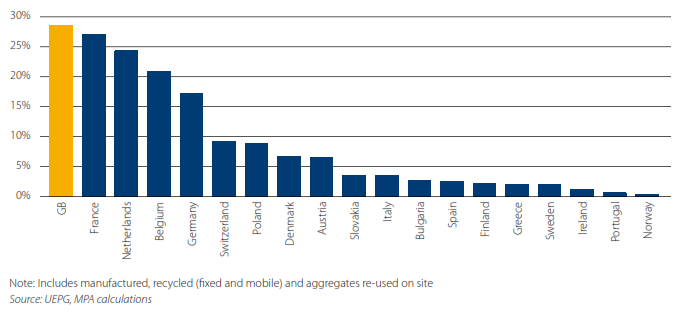Recycled and secondary sources of construction aggregates supplied 28% of total demand in Great Britain in 2018, well ahead of the European average. This is an ongoing success story for the mineral products industry and reflects the sector’s continued commitment to recycling and the circular economy.
In a new report, the Mineral Products Association estimates that in 2018, a total of 71 million tonnes of aggregates from a range of sources have been re-used in construction in Great Britain, 90% (64 million tonnes) of which originated directly from construction activity, through demolition work and road repairs.
Construction activity in built-up areas and on brownfield sites inevitably involves demolition work, generating waste materials such as brick and concrete which are re-used as aggregates. During road maintenance work, the asphalt removed is also entirely re-used. Virtually all construction and demolition waste which can be recycled as aggregates is already being used in accordance with technical and safety standards, leaving limited opportunities for a significantly higher contribution of these materials into the aggregates markets.
The remaining 10% of these aggregates materials are generated as part of other industrial or extractive processes. This includes china and ball clay waste, as well as ash from various sources such as incineration of municipal waste or the manufacture of iron and steel. Whilst there might be some opportunities for a greater contribution of these materials into the wider aggregates market, for instance from china and ball clay waste, stockpiles are located away from the main markets and their use and contribution could only increase with improvements to transport infrastructure. Secondary aggregates sourced from coal-fired power stations are likely to see a continual decline in availability due to the closure of coal power stations.
The Mineral Products Association is concerned by the general paucity of regularly collected and compiled statistics, especially regarding recycled and secondary aggregate use at a national scale. The absence of regular monitoring data about material arising and their use makes it difficult to track the industry’s continuing progress or identify areas where further improvements may be realised through process or regulatory changes. This, in turn, can result in a wider misunderstanding and misrepresentation of the industry’s role in construction, both in terms of primary resource needs and the potential for greater use of materials that are either recycled or from secondary sources as part of the sector’s contribution towards green growth.
In response, the Mineral Products Association has developed a methodology to track the contribution of recycled and secondary aggregates to overall aggregates supply, with the aim of addressing this data gap by modelling available market data.
MPA Director of Economic Affairs, Aurelie Delannoy, said ‘our industry can be proud of the leading role it is playing internationally in maximising the recycling of construction and demolition waste as aggregates. Taken together with the restoration of mineral extraction sites to beneficial after use, the industry is delivering sustainable environmental results whilst others just talk a good game. Having achieved what is likely to be the most we can recover from the waste stream, the focus now has to be on moving recycled and secondary waste up the value chain, and accepting that around 70% of future demand has to be supplied by primary aggregates through the planning system. The MPA has submitted proposals to reform the system as the replenishment of land won reserves, particularly sand and gravel, continues to be unsteady and inadequate.’
Figure 1. Share of recycled and secondary materials in total aggregates sales, 2018

Figure 2. GB aggregates market by sources of supply, 1955-2018

Ends.
Notes for Editors:
A copy of the report can be found here.
For further information, please contact Robert McIlveen at robert.mcilveen@mineralproducts.org. Tel: 0207 963 8000.